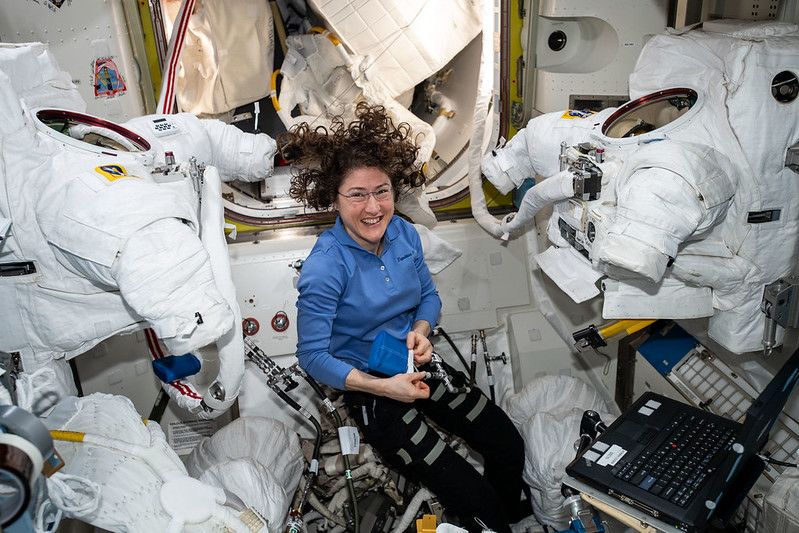NASA wants to change the way it protects astronauts from radiation

Astronauts face a constant specter of radiation, as particles streaming off the sun and high-energy cosmic rays constantly bombard their bodies.
Left unchecked, radiation can trigger all sorts of health issues, most notably boosting an astronaut’s danger of developing cancer. So, when NASA plans missions, the agency uses a radiation exposure cap to determine how long astronauts can stay in space. But that cap isn’t equal for all astronauts, and now, independent experts are backing NASA’s effort to change it.
Currently, NASA calculates that cap based on a risk estimate. The limit is the amount of total exposure that would give an astronaut a 3% higher chance of dying of cancer in the rest of their life, based on available data.
Related: Radiation poses a major obstacle to future Mars-bound astronauts
However, susceptibility to the cancers that radiation can cause varies with age and reproductive organs, so the limit doesn’t allow equal time in space. NASA’s women can’t spend as much time in orbit as NASA’s men, and younger astronauts can’t stay up as long as their older counterparts, who don’t have as many years left for cancer to develop. (Sex isn’t really binary, but such is the data available.)
NASA has previously considered changing this system to a cap that would limit all astronauts’ exposure to the risk limit as applied to the most vulnerable: a 35-year-old woman. Now, a committee of the National Academies of Sciences, Engineering, and Medicine has unveiled a report that supports NASA’s proposal.
In hard units, that’s a total of 600 millisieverts over a career with the agency. For comparison, a single chest X-ray at your doctor’s office gives you around 0.1 millisieverts, and you pick up around 3 millisieverts every year from Earth’s natural background radiation. Workers near Chernobyl’s ground zero in 1986 were showered with 6,000 millisieverts.
Meanwhile, a six-month stay on the International Space Station exposes an astronaut to between 50 and 120 millisieverts, according to the new report; more distant destinations like Mars carry greater exposures.
In effect, the proposed limit would expose younger astronauts and women to comparatively riskier amounts of radiation and reduce the amount of time that older astronauts and men can spend in orbit, according to the report.
NASA’s radiation standards were last updated in 2014. “A lot has changed since then, in terms of our understanding of radiation biology,” Dr. Carol Scott-Conner, a professor of surgeon at the University of Iowa who was on the NAS committee, told Space.com.
Many radiation exposure standards are based on historic studies of survivors from the atomic bombs dropped on Hiroshima and Nagasaki in 1945. Now, that’s being augmented by more recent data, such as that from workers in radiation-heavy industries like nuclear medicine and nuclear power.
The suggested change isn’t supported universally. “I think this change is problematic,” Francis Cucinotta, a radiation biologist at the University of Nevada, Las Vegas, who has previously worked with NASA, told Space.com. He calls the proposal akin to playing Russian roulette with female astronauts, placing them at extra risk from radiation exposure.
But Scott-Conner disagrees. “We agreed with NASA’s conclusion, that the best thing to do was set it according to the standard for the most vulnerable population, which is the 35-year-old woman,” she said. Furthermore, she said that NASA’s exposure limits are significantly lower than those of other space agencies.
However, Cucinotta thinks that focusing solely on cancer risk ignores other problems linked to radiation, such as heart disease and cognitive issues. He thinks NASA ought to look at more data before they make comprehensive changes. “I don’t understand why they’re doing it now,” he said. “There’s plenty of time to do research, this decade, for longer lunar missions or a Mars mission.”
The proposed changes come as NASA prepares to send astronauts beyond Earth’s orbit. The first Artemis program missions to the moon and back aren’t likely to expose their crews to much radiation. But longer spaceflights — for instance, months-long missions to Mars — would well surpass NASA’s limits under either system.
Short of far better radiation shielding, astronauts going to Mars would need to go through a waiver process. The report emphasizes that NASA should set up a clear and transparent framework for making that happen.
In the meantime, Scott-Conner said, scientists have plenty more to learn about how people react to the sort of radiation in space. “There’s a lot that’s different about surviving an atomic bomb and flying a mission to Mars.”
Follow us on Twitter @Spacedotcom and on Facebook.
